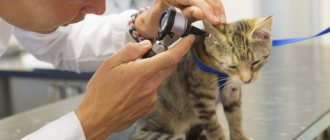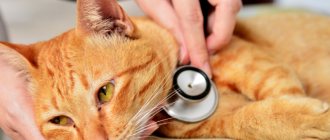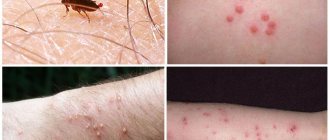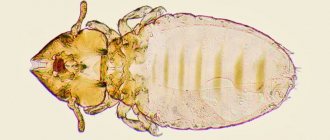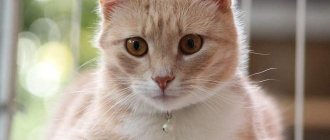What will you learn from the article?
- Types of stomatitis Classification by location
- Classification according to the nature of inflammation
- Classification by origin
- Classification according to the course of the disease
- 10 signs of stomatitis
- What causes primary stomatitis
- How to help your cat before visiting a doctor
Stomatitis in cats is a painful inflammatory disease of the soft tissues of the oral cavity. The danger of this pathology is that if not treated promptly, it can cause serious complications. Inflammatory processes are manifested by redness of the mucous membranes and the appearance of ulcers. Foci of localization of the disease: tongue, corners of the mouth, gums, lips, lingual-palatal folds. In advanced cases, the entire oral cavity of the animal is affected.
Is it possible to prevent stomatitis in cats, what are the symptoms of the pathology, how to help a sick pet, what treatment methods are best - you will find the answers to all these questions in our article.
What is stomatitis
Stomatitis in a cat is an inflammatory disease of the oral mucosa (usually the corners of the mouth, lips, tongue, gums, lingual palatine folds) with possible complications in the absence of proper treatment. It is contagious to animals, so a sick cat should be protected from contact with other pets.
According to localization, the types of the disease can be classified as follows:
- gingivitis - inflammation affects the gums of the animal;
- gingivostomatitis - inflammation covers the mucous membrane of the entire mouth and gums;
- glossitis - affects the tongue;
- palatinitis - affects the palate;
- faucitis - in this case, the palatoglossal folds are subject to inflammation;
- cheilitis - inflammation affects the lips.
According to the duration of the disease, the disease can be acute - up to 2 weeks, subacute - 2-6 weeks, and chronic - more than 6 weeks, in which the animal generally feels unwell.
Features of the pathology
Stomatitis in cats is a disease caused by viruses, which gives the pet unpleasant pain in the mouth. In severe cases of the disease, there is a risk that the animal may lose one or more teeth. Therefore, it is important to identify stomatitis in the early stages and provide your pet with qualified veterinary care and proper care. It is worth noting that this disease can progress to more serious stages, thereby provoking the development of leukemia. This is especially true for cats with reduced immunity.
In the initial stages, the animal's gums are affected, becoming bright red and, in some cases, bluish in color. Over time, they begin to bleed and severe pain appears when chewing, and damage to the mucous membrane spreads throughout the animal’s mouth. In the absence of qualified help and immunity support, stomatitis can be fatal.
An attentive owner is obliged to notice the first signs of the disease as early as possible. If ulcerative stomatitis in cats is detected in the early stages, treatment will be quick and simple.
The first signs of stomatitis in a cat:
- The amount of saliva produced increases;
- Thirst increases;
- Appetite disappears, the process of chewing food becomes longer and more difficult;
- Bad breath appears, which indicates increased microbial activity;
- The mood and desire to play disappear;
- The animal sleeps for a long time and becomes very apathetic;
- Increased body temperature;
- Enlargement of lymph nodes in the neck;
- The mucous membranes of the mouth swell and acquire a red tint, and also acquire a white-gray coating.
If there are several symptoms of the disease, it is necessary to take the animal to the veterinarian as soon as possible.
Main signs of the disease
You can assume that a cat has stomatitis based on the following signs:
- loss of appetite;
- constant thirst appears;
- the cat often rubs its muzzle with its paw or rubs its muzzle against objects/the floor in an attempt to relieve pain;
- temperature rises;
- lack of washing and hygiene due to pain in the mouth;
- increased salivation;
- constantly wet fur around the mouth;
- apathy and drowsiness;
- pinkish saliva - due to bleeding wounds - or viscous and yellowish - due to an admixture of pus;
- swollen lymph nodes in the jaw and neck.
“Murkoshi” volunteers carefully care for each animal and recommend that cat owners not delay visiting the veterinarian if symptoms of illness are detected.
Treatment options
How can stomatitis in cats be treated? There are several treatment options that can completely eliminate the infection. In addition, special medications stop the development of the inflammatory process.
It is worth noting! First of all, you should carefully examine your pet; to do this, you need to take him to an appointment with a veterinarian. The doctor performs a visual examination and asks the owner about the presence of suspicious symptoms. Laboratory tests are required.
Feline stomatitis is treated in several ways:
- Surgery is usually used in cases where the cat has extensive lesions. During it, areas of the mucous membrane that have undergone severe changes are removed. If they are not removed in a timely manner, they will cause serious complications, including complete death of the mucosal tissue. This method is used to treat gangrenous stomatitis. Surgical intervention is performed in the presence of autoimmune processes in which teeth are removed. No more than two teeth are removed at a time;
- Combined treatment method. During it, surgical cleaning of the oral cavity, tooth extraction and further drug therapy are carried out;
- Drug therapy. This type of treatment can be used at home, but under the supervision of a specialist. It is aimed at cleansing the animal’s oral cavity from infection, pus, and tissue decay. It also speeds up the healing process and restores the affected mucous layer.
Causes of stomatitis
Stomatitis in a cat occurs due to any injury or disease. Depending on the causes of the disease, primary and secondary stomatitis are distinguished.
Primary develops when:
— thermal burn (too hot food or inhalation of steam);
— chemical burn (swallowed alkaline solutions, salts of heavy metals, etc.);
- mechanical trauma to the mouth (bad bite, damage to the gums or cheeks from small bones while eating).
Secondary stomatitis in kittens and cats develops against the background of stress, weak immunity or as a result of diseases:
- diabetes mellitus and other difficulties with the endocrine system;
- lack of vitamins (as a rule, stomatitis can be caused by a lack of A, B, C, E and PP);
— infectious (calcivirosis, rhinotracheitis, papillomatosis, etc.);
— renal failure and diseases of the gastrointestinal tract (colitis, gastritis, etc.);
- allergies to medications, food or, conversely, inedible products (plants, shampoo, paint from toys, etc.);
— problems with gums and teeth (periodontitis, periodontal disease, caries, etc.);
— oncology, especially in the neck and head;
- autoimmune diseases.
Stomatitis can also be caused by poor oral hygiene or feeding from dirty dishes. It is necessary to introduce specialized food into the cat’s diet that prevents the deposition of tartar, or to remove it in a timely manner at a veterinary clinic.
Read more: Removing tartar from a cat
Symptoms of a cat having toothache
Of all the symptoms of diseases of the dental system, cat owners usually pay attention to the following:
- Unpleasant odor from the mouth - halitosis.
- Drooling (salivation, ptyalism) is also a sign of nausea.
- Changes in behavior during feeding. A cat may sit over the bowl for a long time, but not eat, or begin to eat, but suddenly scream and run away from the bowl, or rub its face with its paw, as if trying to get into its mouth. Also, a symptom of oral diseases can be a decrease or lack of appetite - since it is painful for the cat to eat, she tries to do it as little as possible.
- Change in the shape of the muzzle: swelling in the nasal or infraorbital region or in the lower jaw.
If the cat is calm, it allows the owner to open its mouth and examine its teeth. You don’t need to immediately try to open the cat’s mouth wide, like at a dentist’s appointment, the cat definitely won’t like it. To see what is needed, it is enough to first lift your lips upward, then pull them towards the corners of your mouth. In this case, changes in the color and shape of teeth, gums, and mucous membranes of the oral cavity can be detected.
If these signs are found, you need to show the animal to a veterinarian to make a diagnosis and choose treatment.
Almost all manipulations in the oral cavity of cats are performed under general anesthesia. You should not be afraid of this; it is impossible to carry out a full diagnosis and treatment (as well as removal of tartar) without the use of anesthesia, and it is risky for the cat; the stress experienced during rigid fixation, the risk of injuries and fractures, is more harmful to the health of the pet than competent sedation under the supervision of a specialist . In addition, blood tests, x-rays and biopsies are sometimes required to confirm the diagnosis.
Unpleasant odor and drooling are nonspecific symptoms; they can also be signs of a large number of different pathologies, including various diseases of the gastrointestinal tract (gastrointestinal tract), and infectious diseases. Therefore, in any case, if such symptoms appear, even if you do not visually detect any problems with your cat’s teeth or gums, it is recommended to consult a veterinarian.
Treatment of stomatitis in adult cats
As Henry Bates said, “Cats are happy creatures. They don’t care about anything at all!” And this is true - until the cat gets sick. Furry pets are not always able to help themselves on their own, and then they need the care of their owner. Well, his duty is to follow the veterinarian’s recommendations.
Depending on the type of stomatitis in a cat, its severity and the general condition of the animal, the doctor may prescribe medication - including drugs and immunomodulatory drugs, surgery - when removal of the affected mucous membrane, tartar or teeth is required, or combination therapy - consisting of surgical intervention followed by prescription of medications.
Widely used drugs for the treatment of stomatitis in cats:
- Antiviral, antimicrobial, antibiotic and antifungal
— “Amoxicillin” 15%. 1 time subcutaneously or intramuscularly, dosage 1ml/10kg (or 15ml/kg).
- "Oxytetracycline." A course of 3-5 days, 1 ruble/day at a dosage of 0.1 ml/kg.
— “Lincomycin” 10%. Dosage intramuscularly – 2ml/10kg, intravenously – 1ml/10kg. Course 3-7 days.
- Oxolinic or Nystatin ointments, "Cholisal". Apply locally, a thin layer to inflamed areas.
- Antiseptics
— “Chlorhexidine” (0.05%). Rinse mouth or treat wounds topically.
- "Dentavedin-gel." 2-3 times a day, apply a thin layer to sore gums or into the sockets of extracted teeth.
— “Lugol” with glycerin, including spray, “Metrogil-denta”, “Protargol” (1.5%). Spray or smear on ulcers.
- Restorative and wound-healing drugs
- “Actovegin-gel”, “Levomekol”, rosehip and sea buckthorn oils. Apply a thin layer to ulcers and wounds when the inflammation has passed.
- Drugs to enhance immunity
- "Kathozal". 0.5-2.5 ml/cat, once. If necessary, repeat after 3-5 days.
- “Gamavit.” 0.3-0.5 ml/kg 1-3 times every 7 days. Course from 2 to 4 weeks.
- “Hemobalance. 0.25 ml/cat weighing up to 5 kg and 0.5 ml/cat over 5 kg, 2-3 times a week.
- For stomatitis that has developed against the background of autoimmune diseases, the following drugs may be prescribed:
- Cyclosporine. 7 mg/kg 1 time per day. The course is from 4 to 16 weeks (depending on the severity of the disease).
- “Prednisolone.” To suppress inflammation – 0.5 mg/kg 2 times a day. For complete treatment – 1-3 mg/kg twice a day.
- Painkillers and disinfectant sprays
— “API-SAN”, “Candioli”, “Zubastic”, “Oral-Relax”.
- Vitamins
Oral diseases in dogs and cats
The most common diseases of the oral cavity and their prevention in dogs and cats.
Carnivorous mammals have two generations of teeth (deciduous and permanent). They belong to heterodonts - animals with several types of teeth that perform different functions. Unlike humans, carnivores practically do not chew their food. They tear it into pieces and swallow it. Therefore, dogs and cats rarely suffer from caries, and they are more likely to develop periodontal disease. These are diseases of the periodontal tissues.
How can you tell if something is wrong with your pet’s mouth?
- Unpleasant odor from the mouth, drooling, tremor of the masticatory muscles, difficulty eating and playing with objects.
- Bleeding, swollen, red gums, ulcers, plaque and tartar on teeth, loose teeth, tooth loss.
- Change in the shape of the muzzle: swelling in the nasal or infraorbital region or in the lower jaw; enlargement of the submandibular lymph nodes.
Plaque and tartar
Plaque deposition and stone formation are facilitated by decreased chewing activity, malocclusion, retained baby teeth, lack of oral hygiene, as well as various diseases such as diabetes, kidney and liver failure, and immunodeficiencies. Already 2 weeks after the formation of dental plaque, tartar is formed as a result of calcification under the influence of mineral salts, mainly calcium contained in saliva (supragingival calculus) or the fluid in which the gingival grooves are immersed (subgingival calculus). The stone itself is not the cause of periodontal disease, but its rough surface provides an ideal environment for plaque and microorganisms to attach. Professional treatment - sanitation (removal of tartar by a veterinarian with ultrasound, removal of subgingival deposits and polishing of teeth) followed by daily brushing helps to reduce the initial loosening of teeth and maintain this condition for several years.
Baby teeth
The change of baby teeth in large dogs begins at approximately 3.5 - 4 months, and in miniature breed dogs this fate befalls approximately six months (and sometimes 7-8 months). First, the molars grow, then the premolars, then the molars, and the last to grow are the canines. The total number of molars in dogs is 42 (20 at the top and 22 at the bottom). In kittens, the replacement of baby teeth with permanent ones begins at approximately 4 months. By 3.5 – 5.5 months. The incisors change by 5.5 – 6.5 months. – canines, by 4 – 5 months. – premolars, by 5–6 months. – molars. A complete change of teeth is completed by 7 months, but can take up to 9 months. An adult cat has 30 permanent teeth. In cats, teeth most often change without any problems; there may be a smell from the mouth and redness of the gums. In dogs, especially small breeds, baby teeth may be retained until adulthood. It is necessary to monitor the process of changing teeth; teeth that do not fall out for too long must be removed, as extra teeth lead to malocclusion, gum damage, rapid formation of tartar, and periodontal disease.
Abnormal position of teeth, malocclusion
If an abnormally located tooth with its tip injures the gum or lip, or interferes with the physiological closure of the jaws, it is necessary to remove it. In case of malocclusion, special mouthguards and braces for dogs can be used, but this can only be done by a specialist; braces cannot be installed in case of gum disease or the presence of tumors. If the dog is not a breeding dog, and the bite does not interfere with the normal functioning of the jaw or damage the gums, it does not need to be corrected, it will only be a cosmetic defect.
Tooth fractures
Injuries and excessive chewing on hard objects can cause teeth to break. In this case, depending on the lesion, the tooth is either removed or covered with a filling.
Foreign bodies in the oral cavity
Bones, threads, needles, wires, thorns from plants, wood chips, rain and tinsel often get stuck in the oral cavity. The animal opens its mouth, sticks out its tongue, rubs its muzzle with its paws or on the ground, floor and furniture. Salivation and increased respiratory rate, coughing, gagging, and refusal to feed may occur. If the foreign object is not removed quickly, it can cause inflammation.
The most common oral diseases are:
Stomatitis
Inflammation of the oral mucosa. The most characteristic signs of stomatitis are painful eating, drooling, and an unpleasant odor from the mouth.
- Catarrhal stomatitis. With this form of the disease there are no obvious wounds or ulcers. There are obvious signs of inflammation - redness, swelling, soreness, and there may be a slight whitish coating in intervals when the animal does not eat or drink. When plaque is removed, bleeding areas of the mucous membrane are formed. It manifests itself in separately inflamed areas, or can cover the entire oral cavity, especially the gums. The beginning of all stomatitis.
- Ulcerative stomatitis - blisters-pimples form on the surface of the mucous membrane, which burst to form small wounds, around which healthy tissue becomes severely inflamed. They are most often found on the surface of the gums, but are also found on the lips and cheeks. With ulcerative stomatitis, the dog often eats with some chewing. Ulcerative stomatitis can be a symptom of leptospirosis in dogs and calcivirosis, feline immunodeficiency virus, and herpes virus infection in cats.
- Atrophic stomatitis. Externally, there is very strong inflammation on the gums and the mucous membrane of the inner surface of the cheeks. If you look closely, you can see tiny bubbles and wounds/ulcers. The surface of the mucous membrane is tense and visually as if stretched from inflammatory edema, as if it was about to burst. The slightest touch to the lesion causes obvious severe pain in the dog. The pet categorically refuses solid food, and in special cases cannot even eat soft food. Gum injuries occur almost instantly with any contact with something hard.
- Phlegmonous stomatitis. This is always a sharply unpleasant odor from the mouth and the presence of pus in wounds, ulcers and its accumulation between the lips and gums. Due to the moist environment, the purulent process spreads throughout the entire oral cavity, affecting any slightest microtrauma and blisters. It is treated only with systemic antibiotic therapy.
- Papillomatous stomatitis. This form of stomatitis is caused by the papilloma virus and is characterized by the formation of specific neoplasms resembling cauliflower - papillomas - on the mucous membranes of the lips and cheeks. Self-medication is prohibited, because there is a high risk of spread and growth of papillomas throughout the oral cavity. Very common in puppies due to weak immunity.
It is impossible to cure stomatitis in a dog on your own without visiting a veterinarian (at least without consequences). No owner will be able to determine exactly what caused this disease. The main point in treatment is to eliminate the cause of inflammation, i.e. Without its precise definition, any treatment procedures will be in vain.
Gingivitis
Inflammation of the gums, caused by the adverse effects of local and general factors and occurring without compromising the integrity of the dentogingival junction. With gingivitis, the gums become bright red and swollen. Eating is difficult. Drooling may occur. Gums are bleeding.
Periodontitis
Inflammation of periodontal tissues (tissues surrounding the tooth), characterized by progressive destruction (destruction) of the periodontium and alveolar bone (tooth socket - the depression in the jaw in which the root of the tooth is located) of the jaw process. The symptoms are similar to those of gingivitis. When examining the oral cavity, pockets in the periodontal zone are found, the teeth are mobile and painful. Loss of teeth is also possible.
Periodontal disease
Dystrophic (pathological condition of tissues, characterized by metabolic disorders and structural changes) periodontal damage. The disease is characterized by a chronic course. As a rule, periodontal disease is a pathological syndrome of common somatic diseases. As the process develops, pallor of the gums, multiple exposure of tooth roots, the appearance of diastemas (increasing the gap between teeth), and fan-shaped divergence of teeth are observed. At later stages, pathological mobility of teeth occurs.
Tooth resorption (in cats) (FORL)
Dental disease in cats, in which the destruction of tooth tissue occurs with the formation of cavities, all tooth structures are destroyed. Externally, the disease may be invisible and can only be detected by x-ray examination of the teeth. Sometimes the gums in the area of the affected tooth become red, may bleed and grow on the crown. Unfortunately, most often teeth affected by this pathology must be removed, since there is currently no effective method of treating this disease.
Caries
It does not appear as often in dogs and cats, but nevertheless occurs. Dental caries refers to damage to the hard tissues of the tooth, often leading to the destruction of enamel and dentin structures. If there is significant destruction of the tooth tissue, accompanied by the formation of cavities, the crown part of the tooth may be destroyed. With deep carious lesions, the inflammatory process can spread to the dental pulp, tooth roots, with possible involvement of periodontal tissues in the inflammation. Caries in animals, just like in humans, has many causes, and it is impossible to single out just one of them. Genetic predisposition definitely plays a huge role, which is realized in problem teeth through immunity, resistance, and the hormonal system. The role of food quality is secondary. Thus, feeding carnivores food rich in carbohydrates (porridge, dry food) and with a lack of food rich in calcium (especially for puppies and kittens), dental plaque can form and enamel defects can form due to disturbances in mineral metabolism. Treatment of a carious tooth depends on the degree of damage - it can be filled or removed.
Tumors
The growth of gum tissue, often covering the teeth, can be intact and uniform in color, or covered with pigment spots, ulcers, areas of necrosis, teeth can become loose, fall out or shift. The muzzle often takes on an asymmetrical shape. Neoplasms can also affect any soft tissue of the oral cavity - gums, palate, tongue, cheeks, pharynx, move into the nasal cavity, and the bone tissue of the jaw can also be destroyed. Tumors of the salivary glands begin with inflammation and occur about twice as often in cats as in dogs. Oral tumors account for approximately 5–10% of all tumors in dogs and cats. In dogs, a significant proportion of neoplasms are benign, while in cats, the majority of neoplasms are malignant. They require a mandatory visit to the veterinarian as soon as they are noticed.
Prevention of oral diseases
There are special chewing bones, sticks, pads that promote cleansing with an abrasive effect on the teeth, as well as toys for brushing teeth and massaging gums.
Many well-known companies that produce pet food add agents to the food that prevent the formation of dental plaque in dogs and cats, for example polyphosphates, essential oils, and also use a special structure of dry food kibble (mechanical cleaning). This only affects plaque and small amounts of tartar. To prevent oral diseases, you need to regularly examine your pet’s oral cavity, clean plaque 1-2 times a week with special pastes and a brush for animals, you can use oral fluids and sprays. If necessary, you need to remove tartar using tools or an ultrasonic scaler; such professional cleaning is done only by a veterinarian.
How to clean teeth from plaque
It is necessary to use special products for animals - human toothpastes are dangerous if swallowed. This procedure also requires special brushes for animals, a finger brush, a bandage wrapped around the finger; for small dogs and cats, you can use small children's brushes with soft bristles that will not harm the pet's health. Toothpastes and gels for dogs do not require rinsing, and often taste quite pleasant to the dog.
- A simple option is to wrap your finger in a bandage, preferably 3-4 layers. Next, apply a special paste or gel and rub your teeth with light movements. When brushing, do not apply force or press hard for fear of scratching the enamel and damaging your gums.
- Apply the paste to the bristles of the brush and gently brush, starting with the far teeth.
- If the procedure is being performed for the first time, it may not be possible to clean all the teeth in one time. Perform the manipulation in a series of techniques.
- There is no need to clean the inside of your pet's teeth every time. The dog can easily clean it on its own.
- It will be necessary to create a calm environment so that the animal perceives the procedure easily. There is no need for cleaning to be associated with unpleasant sensations. During the process, it is recommended to speak kindly to the animal and praise it.
If you discover any problems with the oral cavity, it is very important not to self-medicate, but be sure to contact a veterinarian for tests, correct diagnosis and proper treatment.
Stomatitis in kittens
Children are even more susceptible to this disease than adult animals. This is due to changing teeth and weak immunity. The development of stomatitis in a kitten can also be caused by improper or lack of oral hygiene, poor nutrition, lack of calcium, and various stresses.
It is necessary to monitor the appearance of plaque when changing teeth, the appearance of wounds in the mouth, closely monitor the pet’s well-being, diversify the diet by including vitamins and essential minerals, and periodically examine the baby.
Stomatitis in kittens, as a rule, can be easily cured with the help of solutions, antibiotics, and hygiene.
What to do at home
The owner must strictly follow the veterinarian's instructions. It is prohibited to prescribe medications yourself, increase or decrease their dosage! Some pet owners prefer not to go to a veterinary clinic and treat their pets with folk remedies.
It is not forbidden to use decoctions of medicinal herbs (sage, chamomile, oak bark, etc.), but they should be used as an addition to traditional treatment.
A disease as serious as stomatitis requires adjustments in diet. The diet should be enriched with nutrients and consist of liquid and semi-liquid foods. Chicken and beef broths, pureed soups, and pureed porridges are ideal.
It should be taken into account that a weakened cat, experiencing pain and discomfort when eating, will refuse to eat.
In this case, you should force feed, introducing food into your mouth using a syringe. You need to act carefully so that the animal does not choke.



